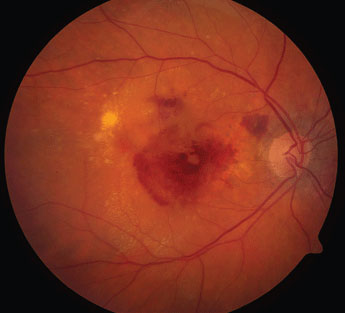 |
This study identified certain genes that put patients at higher risk for developing wet AMD. Photo: NEI. Click image to enlarge. |
The ARMS2/HTRA1 locus at chromosome 10q26 has been recognized as a major contributor to the genetic predisposition toward AMD. As ARMS2 is considered the most enigmatic of the genes for AMD, a recent study investigated the phenotypic course and spectrum of AMD for the risk haplotype at ARMS2/HTRA1.
Ten studies from the European Eye Epidemiology consortium provided data on 17,204 individuals ages 55 and older. AMD features and macular thickness were determined on multimodal images, and data on genetics and phenotype were harmonized. Risks of AMD features for rs3750486 genotypes at the ARMS2/HTRA1 locus were determined by logistic regression and compared with a genetic risk score of 19 variants at the complement pathway.
Compared with other genetic variants, the ARMS2/HTRA1 risk variant had a similar phenotypic pattern of AMD but strikingly greater risks of the end stages at earlier ages. Approximately 65% of late AMD cases carried the ARMS2/HTRA1 risk allele. ARMS2/HTRA1 risk genotypes were not associated with the early manifestations of smaller-sized drusen, which suggests it is a strong enhancer rather than an initiator of AMD.
Previous studies have pointed out that carriers of the ARMS2/HTRA1 risk haplotype have a strong susceptibility to CNV, reticular pseudodrusen, large drusen, GA progression and more severe visual outcomes, and this study confirmed these findings.
Homozygous carriers were shown to have a three-times higher risk of intermediate AMD, a five-times higher risk of a large macular area covered by drusen and a six-times higher risk of reticular pseudodrusen compared with noncarriers of the risk variant at ARMS2/HTRA1. Homozygous ARMS2/HTRA1 carriers had a significantly higher risk of all end stages, in particular CNV and mixed-late AMD, for which the risk was 13-times higher as compared with noncarriers. Homozygous carriers had a cumulative lifetime risk of 26.8% to develop late AMD, while heterozygous carriers had a risk of 9.4% and noncarriers, 4.4%.
“Not only did carriers have higher risks, age of development of severe stages was also earlier,” the authors explained. “We found age at late AMD diagnosis to be 9.6 years earlier for homozygous carriers, almost twice as early as was reported by others. Correspondingly, they had a more-than four-times increased risk of bilateral visual impairment. Placing these data in a broader perspective, the risk haplotype at ARMS2/HTRA1 has higher risks of the more severe AMD features than any other single AMD risk variant.”
Thee EF, Colijn JM, Cougnard-Gregiore A, et al. The phenotypic course of age-related macular degeneration for ARMS2/HTRA1: the Eye-Risk Consortium. Ophthalmology. February 22, 2022. [Epub ahead of print]. |

